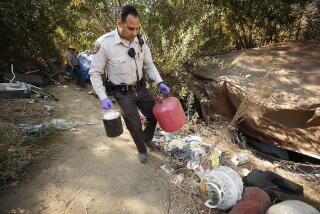Cleator Wants to ‘Streamline’ Police : Calls for 4-Day Work Week but Opposes Pay Initiative
- Share via
In a proposal he argued will “streamline operations . . . and increase public safety,” San Diego City Councilman Bill Cleator on Thursday called for putting police on a four-day work week, expanding the 911 emergency service and integrating the Harbor Police into the San Diego police and fire departments.
At a news conference outside police headquarters downtown, Cleator, who is running for mayor, also expressed opposition to a proposed police pay-raise initiative and suggested that his earlier proposal for a summer jobs program for disadvantaged youths could help reduce the crime rate.
Police Chief Bill Kolender responded favorably to Cleator’s proposal. Ty Reid, president of the San Diego Police Officers Assn., said he was disappointed by Cleator’s opposition to the salary-increase initiative scheduled to appear on the June ballot, but praised Cleator’s other suggestions.
“I guess I can’t give him an A, but I’d probably give him a B-plus,” Reid said.
Similarly, Kolender noted that his department still is reviewing the feasibility of the 10-hour, four-day work week proposed by Cleator, but said that overall, the councilman’s plan “includes some excellent ideas that could increase effectiveness.”
At his news conference, Cleator argued that scrapping the Police Department’s current eight-hour, five-day work week in favor of the so-called “4-10” plan would increase police manpower during high-crime hours and produce “a happier Police Department” where officers would be less prone to stress and burnout.
“I think that (officers) will be more motivated . . . and we will get somewhere between 7% and 8% better coverage, especially in the high-crime hours,” Cleator said.
Reid explained that the proposed new work week “ranks second only to the salary increase in terms of our priorities.”
“It’s a good idea that has worked well in other cities,” Reid said. “It definitely would maximize manpower and increase visibility from 9 p.m. to 2 a.m.,” the highest crime hours, he added.
Kolender said that his department has been studying such a work week revision for the past six months, adding that he expects to make a recommendation to the city manager’s office within the next several weeks.
Such a shift in the work week, Cleator said, would not require the hiring of more police officers, but would cost the city about $500,000, primarily for additional police cars.
Until Thursday, Cleator had remained noncommittal about the controversial police pay-raise initiative, which would give officers a one-time increase of up to 17%--a plan that would cost the city an estimated $10 million.
Cleator said he is “against legislating a pay raise.”
“The City Council has the responsibility of making sure that (all city workers are) paid a fair wage,” Cleator said. “I don’t think we can turn that over to the voters.”
Cleator said he would be “willing to negotiate a fair raise” for police officers and firefighters, but refused to specify what percentage raise he would favor.
In response, Reid said, “We’ve heard promises and more promises for years, and they haven’t been kept. That’s why we’ve had to go to the voters.”
In regard to his other recommendations, Cleator said that:
- Integrating the Harbor Police into the city’s police and fire departments would eliminate duplication of services and help improve public safety at the airport and along the harbor. To accomplish that goal, the San Diego Unified Port District could contract with the city for protection of bayfront areas, Cleator explained.
- Expansion of the 911 emergency telephone program could facilitate the reporting of drunk drivers to the police by citizens with cellular telephones in their autos. However, Cleator said that he had not determined either the extent of the expansion or the cost.
- His earlier announced plan to create about 500 summer jobs for disadvantaged youths could help to reduce crime by “putting these individuals to work and starting to feel good about themselves.” Under his plan, which Cleator estimates would cost about $1 million, youths from areas of high unemployment would help clear brush from open spaces and remove graffiti and trash from urban areas.
More to Read
Sign up for Essential California
The most important California stories and recommendations in your inbox every morning.
You may occasionally receive promotional content from the Los Angeles Times.













